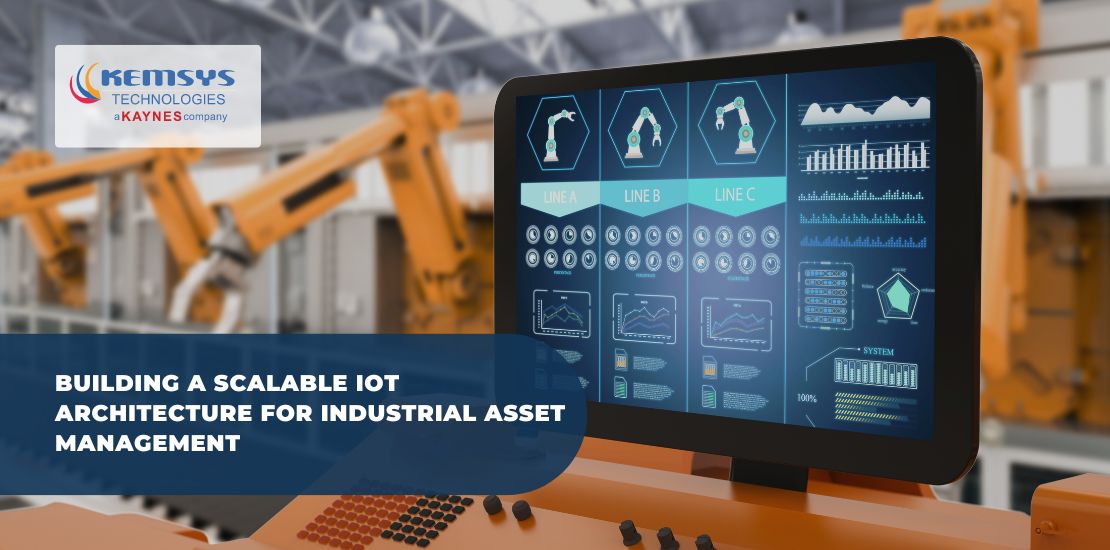Building a Scalable IoT Architecture for Industrial Asset Management
- July 9, 2024
- Posted by: Sanket Pathak
- Category: Industrial Asset Management

IoT-based Industrial Asset Management has revolutionized factories, offering unprecedented efficiency, reliability, insight, and maximum uptime. In an era where operational excellence is vital to success, the importance of IoT-based solutions cannot be overstated. However, to truly harness the power of IoT in industrial settings, a scalable architecture has to be at its backbone.
In industrial settings, a scalable IoT asset management architecture is essential to handle the increasing volume of connected devices and data. Systems and devices get old, which calls for a need for seamless integration with legacy systems, ensuring continuity and maximizing existing investments. This approach future-proofs operations, and this is why businesses need to have a scalable architecture for industrial asset management.
Considerations for Scalable IoT Architecture
Lets explore the key considerations and steps for designing such an architecture, ensuring that your industrial IoT implementation is both robust and future-proof.
Modularity and Flexibility
- IoT architecture cannot be scalable without having modularity and flexibility to accommodate the evolving needs of industrial applications.
- There is a great need to design systems that can easily integrate new components or technologies without the need for extensive reconfiguration. Modular designs enable seamless updates and expansions, ensuring that the system remains relevant as technology advances.
- For example, using microservices architecture allows individual components to be updated or replaced independently without affecting the entire system.
Interoperability
How can scalable architecture be complete without interoperability? It is critical for the smooth operation of IoT systems, especially in industrial environments where disparate devices and platforms are onboarded to coexist.
Ensuring that your IoT architecture supports standard communication protocols such as MQTT, CoAP, Zwave, Bluetooth, and OPC UA among others is essential for enabling different devices to work together harmoniously, thereby maximizing efficiency and reducing integration challenges.
Data Management and Storage
The vast amounts of data generated by IoT devices necessitate robust data management and storage solutions.
- Efficient data handling ensures that valuable insights can be derived in real time, while scalable storage solutions accommodate growing data volumes.
- Implementing a data lake architecture can help manage large datasets by allowing raw data to be stored in its native format. This approach supports a variety of analytics tools and enables efficient data processing.
Security
Security has been the biggest concern since the advent of IoT, particularly in industrial settings, where cyber threats can have severe consequences.
- A scalable IoT architecture must incorporate comprehensive security measures, including encryption (e.g., AES-256), authentication (e.g., OAuth 2.0), and regular security updates, to safeguard sensitive data and ensure system integrity.
- Additionally, employing hardware security modules (HSMs) can enhance the protection of cryptographic keys and other sensitive information.
Scalability
- Intrinsic scalability is a core requirement for any IoT architecture. This involves designing systems that can handle increasing numbers of devices, users, and data volumes without compromising on performance.
- Leveraging containerization technologies such as Docker and orchestration tools like Kubernetes can facilitate horizontal scaling, ensuring that the IoT solution can grow in tandem with the organization’s needs.
Real-Time Processing
- Industrial applications often require real-time processing of data to enable prompt decision-making and responsive actions. Implementing edge computing can facilitate real-time data analysis, reducing latency and enhancing the overall performance of the IoT system.
- Edge devices equipped with efficient processors along with machine learning capabilities can pre-process data locally before sending it to the cloud for further analysis.
Read Our Case Study: IoT Asset Tracking
Steps for Designing a Scalable IoT Architecture
Now that we have discussed the considerations, let’s also discuss the possible steps of designing a scalable IoT architecture.
Define Objectives and Requirements
- The first step in designing a scalable IoT architecture is to clearly define the objectives and requirements of the system.
- Understand the specific needs of the industrial application, including performance expectations, data handling requirements, and scalability goals.
- Utilizing Agile methodologies can help refine these objectives through iterative development and continuous feedback.
Select Appropriate IoT Devices and Sensors
Choosing the right IoT devices and sensors is crucial for the success of the implementation.
- Devices should be selected based on their compatibility, reliability, and ability to meet the specific needs of the industrial application.
- Appropriate device selection ensures longevity and adaptability. Using devices with standardized communication protocols and modular firmware designs can simplify future compatibility-related issues.
Implement Edge Computing
- Edge computing reduces the burden on central servers by processing data closer to the source. This enhances real-time processing capabilities and reduces latency, making it a vital component of a scalable IoT architecture.
- Implementing edge computing ensures that critical data is analyzed promptly, facilitating faster decision-making. Utilizing platforms such as AWS Greengrass or Azure IoT Edge can streamline the deployment of edge computing solutions.
Adopt a Robust Network Infrastructure
A robust network infrastructure is the backbone of any scalable IoT system. It ensures reliable connectivity between devices, sensors, and gateway systems.
- Investing in high-quality network infrastructure, including wireless technologies like 5G and LPWAN (e.g., LoRaWAN), can significantly enhance the scalability and performance of the IoT solution.
- Network redundancy and fallback mechanisms should also be implemented to ensure uninterrupted operation.
Utilize Cloud Services
Cloud services offer the scalability and flexibility needed to manage the vast amounts of data generated by IoT devices.
- Cloud-based platforms provide elastic storage and processing capabilities, ensuring that the system can handle varying workloads and data volumes efficiently.
- Leveraging services like AWS IoT, Microsoft Azure IoT Hub, Google Cloud IoT, and other hybrid or customized cloud solutions, can provide robust frameworks for device management, data analytics, and application deployment. However, it is best to choose based on your requirements.
Integration with Legacy Systems
Seamless integration with existing systems is essential for maximizing the benefits of IoT-based industrial asset management.
- Ensuring compatibility with legacy systems and facilitating smooth data flow between the new IoT architecture and existing operational technologies.
- Utilizing middleware solutions or API gateways can simplify integration efforts and enhance interoperability.
Implement Robust Security Measures
Security must be integrated into every layer of the architecture.
- Implementing strong encryption layers, regular security audits, and continuous monitoring to detect and mitigate threats.
- A proactive security strategy ensures the protection of sensitive data and maintains system integrity. Employing security frameworks like Zero Trust Architecture can provide additional layers of defense thus minimizing the probability of attacks.
Develop a Data Management Strategy
A comprehensive data management strategy is essential for handling the large volumes of data generated by IoT devices.
This involves implementing efficient data storage solutions, data analytics tools, and data governance policies to ensure the effective use and protection of data. Utilizing big data platforms such as Apache Hadoop or Spark can enable scalable and efficient data processing.
Monitoring and Optimizing Performance
Continuous monitoring and optimization are crucial for maintaining the performance and scalability of the IoT system. This involves regularly assessing system performance, identifying bottlenecks, and making necessary adjustments to ensure optimal operation. Implementing monitoring tools like Prometheus and Grafana can provide real-time insights into system performance and facilitate proactive maintenance.
Plan for Future Growth
Finally, planning for future growth is essential to ensure the long-term success of the IoT architecture. A long-term vision of future needs, adopting evolving technological advancements, and designing the system to accommodate innovations and expansions aid success. Incorporating scalability into the initial design and utilizing modular and flexible components can simplify future expansions and upgrades.
Conclusion
The future of efficient IoT-based industrial asset management can only be made effective with a scalable architecture. By considering the key factors and following the outlined steps, organizations can design IoT architectures that not only meet current needs but are also prepared for future growth. To know more about scalable IoT-based industrial asset management, contact our team of experts.

